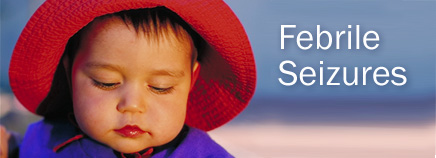
Febrile seizures are convulsions that can happen during a fever (febrile means “feverish”). They affect kids 3 months to 6 years old, and are most common in toddlers 12–18 months old. The seizures usually last for a few minutes and are accompanied by a fever above 100.4°F (38°C).
While they can be frightening, febrile seizures usually end without treatment and don’t cause other health problems. Having one doesn’t mean that a child will have epilepsy or brain damage.
About Febrile Seizures
There are two types of febrile seizures:
- Simple febrile seizures are usually over in a few minutes, but in rare cases they can last up to 15 minutes. During this type of seizure, a child’s whole body may convulse, shake, and twitch; his or her eyes may roll; and he or she may moan or become unconscious. Children can sometimes vomit or urinate (pee) on themselves during the convulsions.
- Complex febrile seizures can last more than 15 minutes or happen more than once in 24 hours. They may also involve movement or twitching of just one part of the body.
Febrile seizures stop on their own, while the fever may continue for some time. Some kids might feel sleepy afterward; others feel no lasting effects.
No one knows why febrile seizures happen, although evidence suggests that they’re linked to certain viruses and the way that some children’s developing brains react to high fevers.
Kids with a family history of febrile seizures are more likely to have one, and about 1 in every 3 kids who have had one seizure will have another (usually within the first 1–2 years of the first). Kids who are younger (under 15 months) when they have their first febrile seizure are also at higher risk for a future febrile seizure. Most children outgrow having febrile seizures by the time they are 5 years old.
Febrile seizures are not considered epilepsy (seizure disorder), and kids who’ve had one have only a slightly increased risk for developing epilepsy.
What to Do
If your child has a febrile seizure, stay calm and:
- Make sure your child is on a safe surface, such as the floor, and cannot fall down or hit something hard.
- Lay your child on his or her side to prevent choking. This is especially important if your child has a lot of saliva coming out of the mouth.
- Watch for breathing problems, including any color change in your child’s face.
- If the seizure lasts more than 5 minutes, or your child turns blue, it may be a more serious type of seizure — call 911 right away.
It’s also important to know what you should not do during a febrile seizure:
- Do not try to hold or restrain your child.
- Do not put anything in your child’s mouth.
- Do not try to give your child fever-reducing medicine.
- Do not try to put your child into cool or lukewarm water to cool off.
When the seizure is over, call your doctor for an appointment to determine the cause of the fever. The doctor will examine your child and ask you to describe the seizure. In most cases, no additional treatment is needed. Tests might be done if your child is under 1 year old and had other symptoms, like vomiting or diarrhea.
The doctor may recommend the standard treatment for fevers, which is acetaminophen or ibuprofen. Giving these medicines around the clock is not recommended and won’t prevent febrile seizures.
If your child has more than one or two febrile seizures that last more than 5 minutes, the doctor might prescribe an anti-seizure medicine to give at home.
When to Call 911
Take your child to the emergency room or call 911 if:
- the seizure lasts more than 5 minutes
- the seizure involved only certain parts of the body instead of the whole body
- your child is having trouble breathing or is changing color
- your child looks sluggish and is not responding normally
- your child doesn’t go back to normal behavior for an hour or more after the seizure
- your child looks dehydrated
- another seizure happens within 24 hours
A child who hasn’t gotten certain vaccines and has a febrile seizure could be at greater risk for meningitis, a disease that affects the membranes covering the brain and spinal cord. Get immediate medical care if your child has any signs of meningitis, such as a stiff neck, a lot of vomiting, or, in infants, a bulging soft spot on the head.
Febrile seizures can be scary to witness, but remember that they’re fairly common and are not usually a symptom of serious illness. In most cases, they don’t lead to any health or developmental problems. If you have questions or concerns, talk with your doctor.

